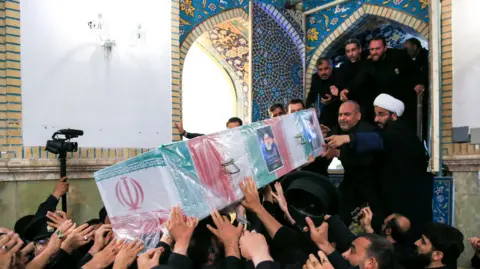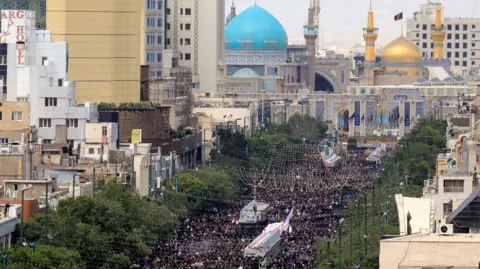 Reuters
Reuters
Ebrahim Raisi was laid to rest inside the Imam Reza Shrine, one of the holiest places in Shia Islam
Iran’s late President, Ebrahim Raisi, has been buried in his home city of Mashhad, four days after he was killed in a helicopter crash.
The 63-year-old hard-line cleric was laid to rest in the holy shrine of Imam Reza, a revered figure in Shia Islam.
TV pictures showed large crowds gathered in one of the north-eastern city’s main streets ahead of the ceremony.
Seven other people died in Sunday’s crash during bad weather in Iran’s mountainous north-west.
They include Raisi’s foreign minister, Hossein Amir-Abdollahian, 60, who was buried on Thursday at the Shah Abdol-Azim shrine in Rey, a southern suburb of the capital Tehran.
Acting President Mohammad Mokhber, who will serve until an election is held on 28 June, was present there to make preparations for the burial.
Ebrahim Raisi’s burial at the gold-domed Imam Reza Shrine – a memorial to the eighth Shia imam – which is considered the holiest in Iran, came after three days of ceremonies elsewhere.
State media described Thursday’s event as “historic”, while Mashhad’s mayor was quoted as saying that “three million mourners” had attended – a figure almost equal to the city’s entire population.
Earlier, thousands also turned out to watch his coffin being driven through the eastern city of Birjand, where Raisi had been the representative to the Assembly of Experts.
On Wednesday, leaders and other dignitaries from the country’s allies and neighbours attended a commemorative event in Tehran.
Also present were representatives of the so-called “Axis of Resistance”, a loose network of armed groups which receive Iranian weapons, training and funds.
They included the political leader of the Iran-backed Palestinian armed group Hamas, Ismail Haniyeh, the deputy secretary-general of Lebanon’s Hezbollah movement, Naim Qassem, the spokesman of Yemen’s Houthis, Mohammed Abdulsalam, and the head of Iraq’s paramilitary Popular Mobilisation Forces, Faleh al-Fayad.
Senior Western officials were noticeably absent from the ceremony, reflecting their countries’ strained relations with Iran.
Iran’s Supreme Leader, Ayatollah Ali Khamenei, also led prayers for those killed.
“[The president’s death] was a difficult issue for us, but the Iranian nation will turn this bitter incident into an opportunity,” he told the speaker of Lebanon’s parliament, Nabih Berri.
Raisi was close to the 85-year-old supreme leader, who is the ultimate authority in the Islamic Republic, and was widely seen as a potential successor.
Tens of thousands of people have taken part in the funeral processions in recent days, which the government and state media have portrayed as demonstrations of national unity.
“How do I find someone like him? I’m really worried about that,” Mohsen, a cleric from Qom, told AFP news agency at Wednesday’s funeral procession in Tehran. “As far as I know, we don’t have anyone of his stature.”
Civil servant Ali Mousavi-Nejad, said the presence of so many people “sends a message to the enemies of the revolution”.

 EPA
EPA
An Iranian presidency handout photo showed large crowds gathered near the gold-domed Imam Reza Shrine in Mashhad ahead of Ebrahim Raisi’s burial
However, many more people have stayed at home, with some even celebrating the president’s death despite prosecutors warning that they could face prosecution.
Millions despised Raisi for overseeing the deadly crackdown on the “Woman, Life, Freedom” protests that erupted in 2022, a year after he took office.
He also faced calls for an international investigation into his alleged role on the “death committee” which ordered the mass executions of political prisoners in the 1980s.
His time as president will also be remembered for a deepening economic hardship and an unprecedented direct military confrontation with Israel last month, which raised fears of a regional war.
A female student, who took part in the protests two years ago, told the BBC: “People are so happy. Most of them are wearing white or bright colours and smiling at each other.”
“The image they keep showing to the world [is] that we’re all sad, that we loved him. But it isn’t true.”
She added: “Today, when I attended my classes, there was a big banner of his face in the university’s main hallway. And the students would show the middle finger to his picture.”
The student also said the streets of Tehran were “full of security patrols” to deter protests or celebrations.
Hadi Ghaemi, the director of the US-based Center for Human Rights in Iran (CHRI) advocacy group, said Raisi’s death should not be exploited to further crack down on civil society.
“Raisi was a pillar of a system that jails, tortures, and kills people for daring to criticize state policies,” he said. “His death has enabled him to escape being held accountable for his many crimes and the state’s atrocities committed under his rule.”
Iranian authorities say they are still investigating what caused the helicopter crash in which he died.
Officials have said the aircraft – a decades-old, US-made Bell 212 – hit a mountainside as it flew to the north-western city of Tabriz in fog and heavy rain.
Raisi was travelling with Amir-Abdollahian, the governor of East Azerbaijan province, Malek Rahmati, and Tabriz’s Friday prayer leader, Ayatollah Mohammad Ali Al-e Hashem, as well as the head of the presidential security team and the helicopter’s three crew following the inauguration of two dams on the border with Azerbaijan.
Source link: https://www.bbc.com/news/articles/cg66l42ngnro

